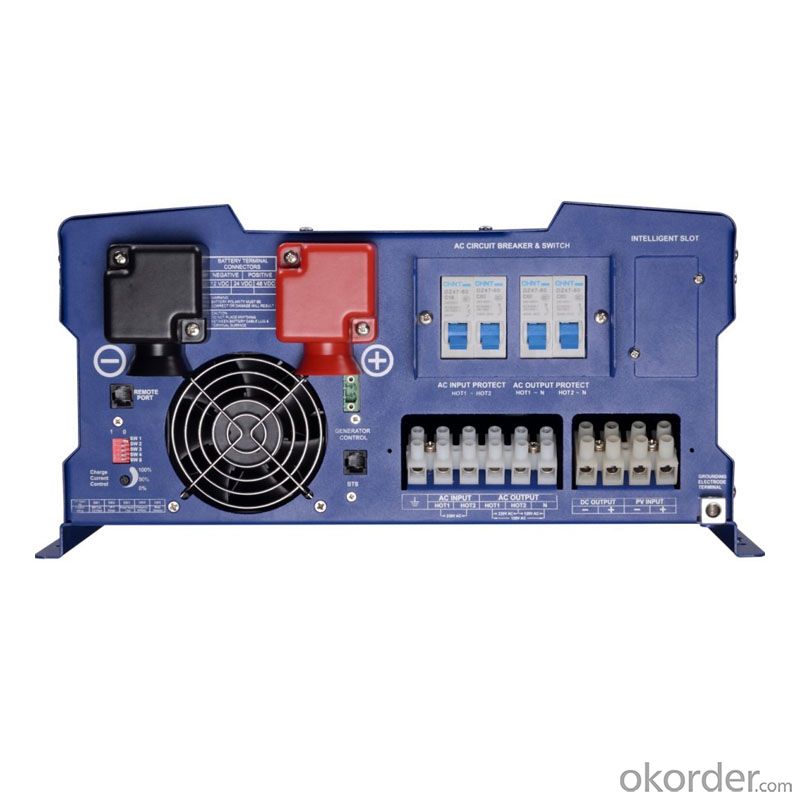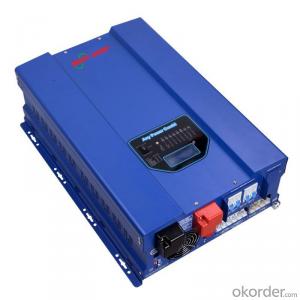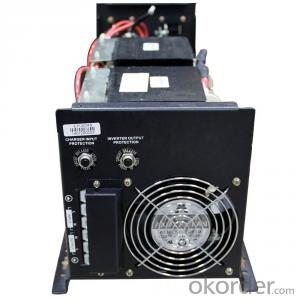Solar Inverter 1kva Pure Sine Wave Inverter Low Frequency EP3000 Series 8kw-12kw
- Loading Port:
- China main port
- Payment Terms:
- TT OR LC
- Min Order Qty:
- 10 pc
- Supply Capability:
- 1000 pc/month
OKorder Service Pledge
OKorder Financial Service
You Might Also Like
Features:
. Smart Remote Control (RMT)
. Battery Temperature Sensor (BTS)
. Automatic Generator Starting (AGS)
. Support Solar Panel with MPPT Function
. Designed to Operate under Harsh Environment
. DC Start & Automatic Self-Diagnostic Function
. Compatible with Both Linear & Non-Linear Load
. Easy to Install & Easy to Operate & Easy to Solve
| Model | 8.0KW | 10.0KW | 12.0KW | |
| Inverter Output | Continuous Output Power | 8.0KW | 10.0KW | 12.0KW |
| Surge Rating(20ms) | 24.0KW | 30.0KW | 36.0KW | |
| Output Waveform | Pure Sine wave/Same as input(Bypass Mode) | |||
| Nominal Efficiency | >88%(Peak) | |||
| Line Mode Efficiency | >95% | |||
| Power Factor | 0.9-1.0 | |||
| Nominal Output Voltage rms | 100-110-120Vac / 220-230-240Vac | |||
| Output Voltage Regulation | ±10% RMS | |||
| Output Frequency | 50Hz ± 0.3Hz/60Hz ± 0.3Hz | |||
| Short Circuit Protection | Yes( 1sec after fault ) | |||
| Typical transfer Time | 10ms(Max) | |||
| THD | < 10% | |||
| DC Input | Nominal Input Voltage | 12.0Vdc | ||
| ( *2 for 24Vdc, *4 for 48Vdc) | ||||
| Minimum Start Voltage | 10.0Vdc | |||
| Low Battery Alarm | 10.5Vdc / 11.0Vdc | |||
| Low Battery Trip | 10.0Vdc / 10.5Vdc | |||
| High Voltage Alarm | 16.0Vdc | |||
| Low Battery voltage recover | 15.5Vdc | |||
| Idle Consumption-Search Mode | < 25 W when Power Saver On | |||
| Charger | Output Voltage | Depends on battery type | ||
| Charger Breaker Rating | 40A | |||
| Max Charge Power Rate | 1/3 Rating Power | |||
| Battery Initial Voltage for Start Up | 10-15.7V for 12V( *2 for 24V, *4 for 48V) | |||
| Over Charge Protection Shutdown | 15.7V for 12V (*2 for 24V, *4 for 48V) | |||
| Remote Control | Yes(Optional) | |||
| Bypass & Protection | Input Voltage Waveform | Sine wave (Grid or Generator) | ||
| Nominal Voltage | 230Vac | |||
| Max Input AC Voltage | 150VAC For 120Vac LV Mode;300VAC For 230Vac HV Mode; | |||
| Nominal Input Frequency | 50Hz or 60Hz (Auto detect) | |||
| Low Freq Trip | 47±0.3Hz for 50Hz, 57±0.3Hz for 60Hz | |||
| High Freq Trip | 55±0.3Hz for 50Hz, 65±0.3Hz for 60Hz | |||
| Overload protection(SMPS load) | Circuit breaker | |||
| Output Short circuit protection | Circuit breaker | |||
| Bypass breaker rating | 50A | 63A | 63A | |
| Transfer switch rating | 80amp for UL | |||
| Bypass without battery connected | Yes (Optional) | |||
| Max bypass current | 80amp | |||
| Solar Charger (Optional) | Rated Voltage | 12Vdc / 24Vdc / 48Vdc | ||
| Solar Input Voltage Range | 15-30Vdc / 30-55Vdc / 55-100Vdc | |||
| Rated Charge Current | 40 ~ 60A | |||
| Rated Output Current | 15A | |||
| Self Consumption | < 10mA | |||
| Bulk Charge(Default) | *2 for 24Vdc, *4 for 48Vdc | |||
| Floating Charge(Default) | ||||
| Equalization Charge(Default) | ||||
| Over Charge Disconnection | ||||
| Over Charge Recovery | ||||
| Over Discharge Disconnection | ||||
| Over Discharge Reconnection | ||||
| Temperature Compensation | ||||
| Ambient Temperature | 0 ~ 40°C(Full load) 40 ~ 60°C(Derating) | |||
| Mechanical Specifications | Mounting | Wall Mount | ||
| Inverter Dimensions(L*W*H) | 588*415*200mm | |||
| Inverter Weight(Solar Chg)KG | 60+2.5 | 66+2.5 | 70+2.5 | |
| Shipping Dimensions(L*W*H) | 750*520*310mm | |||
| Shipping Weight(Solar Chg)KG | 62+2.5 | 68+2.5 | 72+2.5 | |
| Display | Status LEDs / Status LEDs+LCD | |||
| Standard Warranty | 1 Years (Optional) | |||
Warranty
provides a 1~3 year limited warranty (“Warranty”) against defects in materials and workmanship for its Uninterruptible power supply, Power inverter/chargers, Solar charge controllers, Battery Products (“Product”).
The term of this Warranty begins on the Product(s) initial purchase date, or the date of receipt of the Product(s) by the end user, whichever is later. This must be indicated on the invoice, bill of sale, and/or warranty registration card submitted to MUST-Solar. This Warranty applies to the original MUST-Solar Product purchaser, and is transferable only if the Product remains installed in the original use location.




FAQ
1. How do I decide which system is right for me ?
For protection from long outages, include a generator or solar panels in your Must solar system. Shorter outages can be handled by a battery-only system.
2. Where my system will be installed ?
Must solar systems are usually wall-mounted near a home's main electrical (circuit breaker) panel.
3. How do I install my system ?
A must solar backup inverter is connected to a home electric system , we will supply detailed installation manual and videos for our customers .
- Q: Can a solar inverter be upgraded or expanded?
- Yes, a solar inverter can be upgraded or expanded. Upgrades can involve increasing the capacity or efficiency of the existing inverter, while expansion typically refers to adding more inverters to the system to accommodate additional solar panels or increase the overall energy output. However, it is important to consult with a professional to ensure compatibility and proper integration with the existing solar power system.
- Q: How does a solar inverter handle variations in grid frequency?
- A solar inverter handles variations in grid frequency by constantly monitoring the frequency of the grid and adjusting its own output accordingly. It does this through a process called frequency synchronization, where it synchronizes its output frequency with the grid frequency. This allows the solar inverter to seamlessly adapt to any changes in grid frequency, ensuring a stable and reliable power supply to the connected solar panels or the grid.
- Q: How does a solar inverter handle grid frequency deviations?
- A solar inverter handles grid frequency deviations by constantly monitoring the grid frequency. When the grid frequency deviates from the standard range, the inverter adjusts its output frequency accordingly to match the grid frequency. This allows the inverter to maintain synchronization with the grid and continue injecting power efficiently, ensuring stability and reliability of the solar power system.
- Q: How does a solar inverter handle harmonic distortion?
- A solar inverter handles harmonic distortion by incorporating various filtering and control mechanisms. These mechanisms help to minimize and mitigate the impact of harmonic distortion caused by the non-linear loads associated with solar panels. The inverter typically employs filters and algorithms that actively monitor and adjust the output waveform to reduce harmonics. This ensures that the generated electricity is of high quality and meets the required standards for grid connection.
- Q: What is the purpose of a solar inverter?
- The purpose of a solar inverter is to convert the direct current (DC) electricity produced by solar panels into alternating current (AC) electricity that can be used to power household appliances and be fed back into the electrical grid.
- Q: What is the role of a solar inverter in power quality management?
- The role of a solar inverter in power quality management is to convert the direct current (DC) generated by solar panels into alternating current (AC) that can be used to power electrical devices. Additionally, solar inverters play a crucial role in managing and maintaining the quality of power supplied to the grid, ensuring it meets the required voltage and frequency standards. They help in mitigating issues like voltage fluctuations, harmonics, and power factor imbalances, thereby improving the overall power quality and stability of the electrical system.
- Q: Can a solar inverter be used with a solar-powered desalination system?
- Yes, a solar inverter can be used with a solar-powered desalination system. A solar inverter is responsible for converting the direct current (DC) produced by solar panels into alternating current (AC) that is required to power electrical devices. In the case of a solar-powered desalination system, the solar panels generate DC electricity, which is then converted by the inverter to AC power to operate the desalination system's pumps, motors, and other electrical components. This allows the system to utilize solar energy efficiently and sustainably for the desalination process.
- Q: Can a solar inverter be used with any type of solar panel?
- No, a solar inverter cannot be used with any type of solar panel. The compatibility between the solar inverter and solar panel depends on the type of technology used in the solar panel, such as monocrystalline, polycrystalline, or thin-film. It is essential to match the specifications and voltage requirements of the solar inverter with the solar panel to ensure efficient and safe operation.
- Q: Can a solar inverter be used with a solar-powered electric gate system?
- Yes, a solar inverter can be used with a solar-powered electric gate system. The solar inverter is responsible for converting the direct current (DC) produced by the solar panels into alternating current (AC) that can be used to power the electric gate system. This allows for efficient and reliable operation of the gate system using solar energy.
- Q: Are there any government incentives for installing solar inverters?
- Yes, there are government incentives available for installing solar inverters. Many countries offer tax credits, grants, or rebates to encourage the adoption of solar energy. These incentives vary depending on the region and may also include net metering programs or feed-in tariffs, which allow solar system owners to sell excess electricity back to the grid. It is advisable to research and consult local government agencies or renewable energy organizations to determine the specific incentives available in your area.
Send your message to us
Solar Inverter 1kva Pure Sine Wave Inverter Low Frequency EP3000 Series 8kw-12kw
- Loading Port:
- China main port
- Payment Terms:
- TT OR LC
- Min Order Qty:
- 10 pc
- Supply Capability:
- 1000 pc/month
OKorder Service Pledge
OKorder Financial Service
Similar products
Hot products
Hot Searches
Related keywords






























